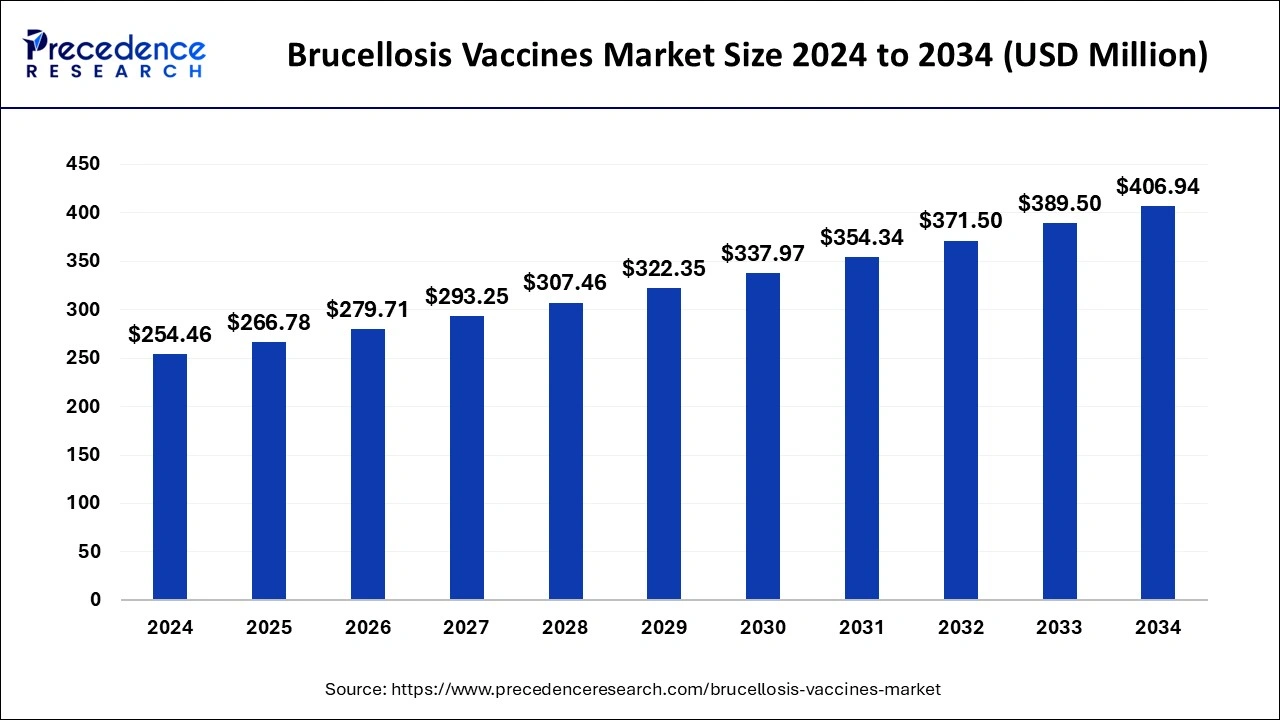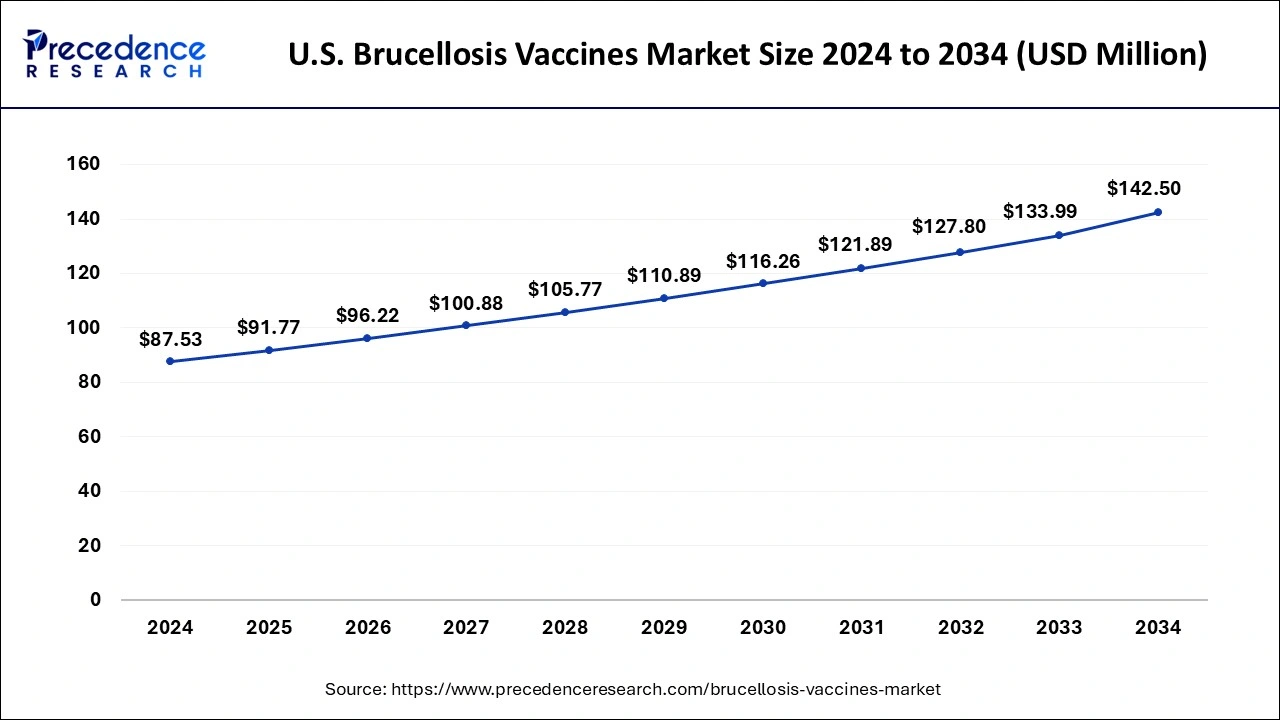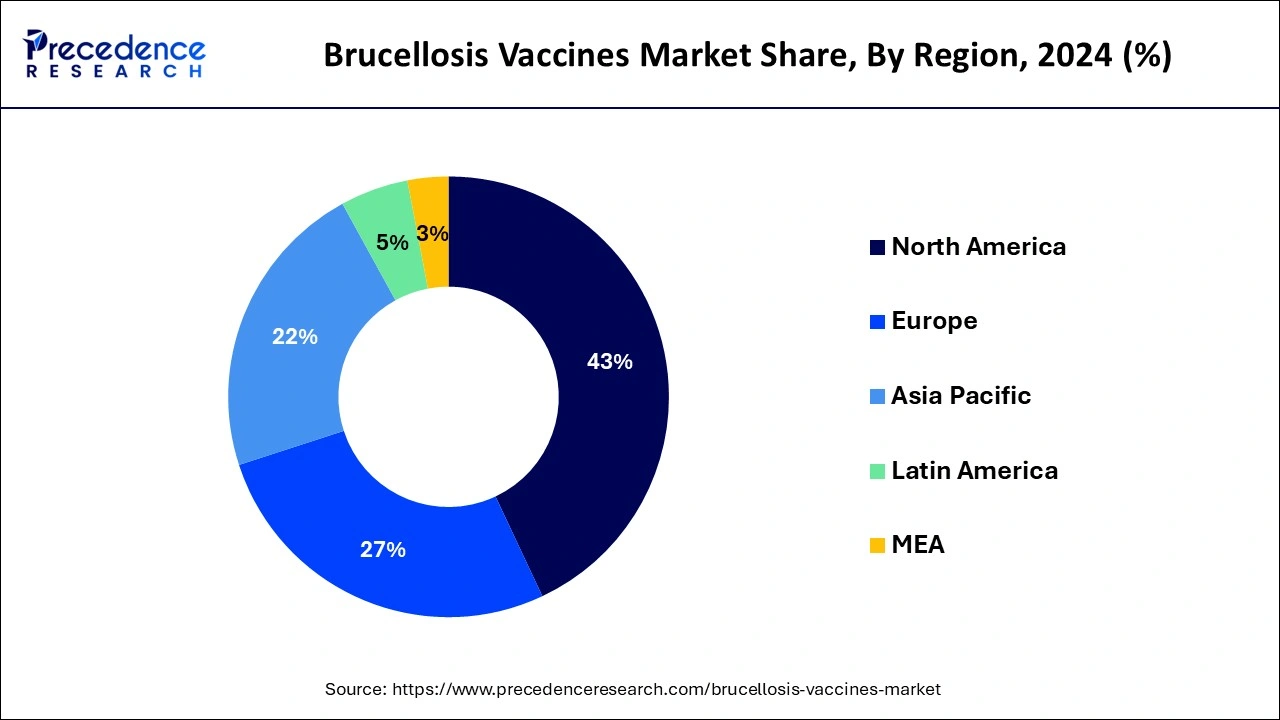April 2025
The global brucellosis vaccines market size is calculated at USD 266.78 million in 2025 and is forecasted to reach around USD 406.94 million by 2034, accelerating at a CAGR of 4.81% from 2025 to 2034. The North America brucellosis vaccines market size surpassed USD 109.42 million in 2024 and is expanding at a CAGR of 4.93% during the forecast period. The market sizing and forecasts are revenue-based (USD Million/Billion), with 2024 as the base year.
The global brucellosis vaccines market size was estimated at USD 254.46 million in 2024 and is predicted to increase from USD 266.78 million in 2025 to approximately USD 406.94 million by 2034, expanding at a CAGR of 4.81% from 2025 to 2034. This can be attributed to the rising incidence of brucellosis and vaccination campaigns. As more nations invest in their national vaccination programs, the potential for growth in this brucellosis vaccines market is expanding globally.

The U.S. brucellosis vaccines market size surpassed USD 87.53 million in 2024 and is expected to be worth around USD 142.50 million by 2034 at a CAGR of 4.99% from 2025 to 2034.

North America dominated the brucellosis vaccines market share in 2024. This strong performance is due to several factors unique to the region's landscape. North America experiences a higher incidence of brucellosis compared to other continents, leading to a significant demand for vaccines as a preventive measure, which in turn drives market growth.
The region's advanced veterinary healthcare infrastructure, including well-established research and development facilities and sophisticated diagnostic capabilities, has also played a crucial role in shaping the market. These factors have facilitated the production and adoption of advanced Brucellosis vaccines, contributing to North America's leading position in the brucellosis vaccines market.

Asia Pacific is projected to experience the highest growth rate during the forecast period. This is driven by a strong demand for brucellosis vaccines in the region over recent decades, fueled by a large consumer base and growing awareness about the vaccine among them.
Brucellosis is a bacterial infection that can be transmitted from animals to humans. It typically spreads through the consumption of unpasteurized milk, contaminated food, and undercooked meat; the bacteria, known as Brucella, reside in the reproductive organs of infected animals, leading to infertility and miscarriages. Vaccination plays a crucial role in controlling bovine brucellosis, particularly in protecting cattle from infection and miscarriages. Different vaccine strains, such as RB51 and S19, are used to prevent brucellosis in animals like sheep, pigs, and cattle. However, it's important to note that the availability and usage of these vaccines may vary depending on the region due to ongoing research and regulatory approvals.
| Report Coverage | Details |
| Market Size in 2025 | USD 266.78 Million |
| Market Size by 2034 | USD 406.94 Million |
| Growth Rate from 2025 to 2034 | CAGR of 4.81% |
| Largest Market | North America |
| Base Year | 2024 |
| Forecast Period | 2025 to 2034 |
| Segments Covered | By Type, By Vaccine, By Application, and By Distribution Channel |
| Regions Covered | North America, Europe, Asia-Pacific, Latin America, and Middle East & Africa |
Rising global livestock population
The brucellosis vaccines market is thriving due to the increasing global livestock population. As the number of livestock grows, there's a greater need for effective vaccines to manage and prevent brucellosis in animals, which in turn drives market expansion. Government support and strict regulations mandating brucellosis prevention in livestock play an important role in driving market growth.
The enforcement of preventive vaccination programs and adherence to regulations significantly contribute to the market's growth. Furthermore, continuous advancements in vaccine development technologies, leading to improved efficacy and safety profiles, are boosting the market. Innovations in vaccine creation result in more efficient and reliable options, which can further foster market growth.
Limited accessibility in remote regions and funding for research
The brucellosis vaccines market faces challenges in reaching remote and underdeveloped regions due to limited accessibility. Infrastructure limitations make it difficult to distribute vaccines, hindering market growth in these areas. Additionally, insufficient funding for research and development in brucellosis vaccine technology is a barrier. This lack of financial resources hampers innovation and the introduction of better vaccines, impacting market growth. Moreover, public concerns and skepticism about vaccine safety could slow market growth. Transparent communication and thorough safety assessments are essential to address these concerns and ensure market success.
Efforts made by government and non-government organizations
Government and non-government organizations' efforts to raise awareness about animal health and diseases are driving growth in the brucellosis vaccines market. Many countries are implementing plans and guidelines for animal welfare while launching brucellosis vaccination programs for cattle and other animals. These initiatives are expected to have a positive impact on the market. Additionally, the introduction of the national livestock identification system (NLIS), which tags animals with radiofrequency identification devices, particularly benefits the cattle sector and contributes to the growth of the brucellosis vaccines market.
The RB51 vaccine segment dominated the market in 2024. This can be linked to the high demand for the RB51 vaccine globally. The rising cases of brucellosis are anticipated to fuel the demand for the RB51 vaccine, which can drive the segment's growth. Moreover, robust preference and acceptance for RB51 vaccines over other vaccines within the market can also contribute to the market expansion.
The S19 segment is expected to show the fastest growth over the forecast period. The S19 vaccine protects cattle against the natural infection caused by Brucella melitensis. The diversity offered by this type of vaccine has enabled stakeholders and healthcare practitioners to address needs effectively.
The market for brucellosis vaccines witnessed a significant surge in the cattle segment, where it held a strong market position. This was mainly due to increased attention to bovine health and recognition of the economic impact of brucellosis in cattle. Cattle, being crucial globally, saw notable adoption of brucellosis vaccines, driven by heightened awareness among farmers and regulatory efforts promoting disease prevention. The high market share reflects the effectiveness and acceptance of brucellosis vaccines in protecting cattle herds, thus ensuring a more secure and sustainable livestock industry.
The sheep and goat segment is observed to grow at a significant rate during the forecast period in the brucellosis vaccines market. Ongoing research and development efforts have led to the development of improved brucellosis vaccines for sheep and goats. Modern vaccine formulations offer enhanced efficacy, safety, and ease of administration, making them suitable for use in diverse livestock production systems. The availability of advanced vaccines encourages widespread adoption and contributes to the expansion of the sheep and goat segment in the brucellosis vaccines market.
Brucellosis is a zoonotic disease, meaning it can be transmitted from animals to humans. The One Health approach emphasizes the interconnectedness of human, animal, and environmental health and advocates for collaborative efforts to address shared health challenges. Vaccinating sheep and goats against brucellosis not only protects animal health but also reduces the risk of human exposure to the bacteria, highlighting the importance of vaccination in both veterinary and public health strategies.
The vector vaccines segment held a considerable share of the brucellosis vaccines market in 2024. Vector vaccines have the potential to provide long-lasting protection against brucellosis by inducing durable immune memory. Once administered, these vaccines can activate the immune system to recognize and respond to Brucella antigens upon subsequent exposure, thereby conferring sustained immunity against infection.
Vector vaccines offer flexibility in vaccine design and antigen selection, allowing for the incorporation of multiple Brucella antigens or genetic modifications to enhance vaccine efficacy. This versatility enables researchers to tailor vector vaccines to target different Brucella species or strains prevalent in specific geographical regions, optimizing vaccine effectiveness and coverage.
The public segment had the largest share of the brucellosis vaccines market in 2024, mainly because more people visited veterinary clinics and hospitals to diagnose and treat brucellosis in animals, both in developed and developing countries. Additionally, government and non-governmental organizations are increasing awareness about animal health, welfare, and disease prevention through various programs, which is expected to further boost the segment's growth in the future. As the market continues to evolve, changes in the distribution landscape are expected, influenced by factors like consumer preferences, technological advancements, and strategic partnerships.
By Type
By Vaccine
By Application
By Distribution Channel
By Geography
For inquiries regarding discounts, bulk purchases, or customization requests, please contact us at sales@precedenceresearch.com
No cookie-cutter, only authentic analysis – take the 1st step to become a Precedence Research client
April 2025
June 2024
January 2025
February 2025